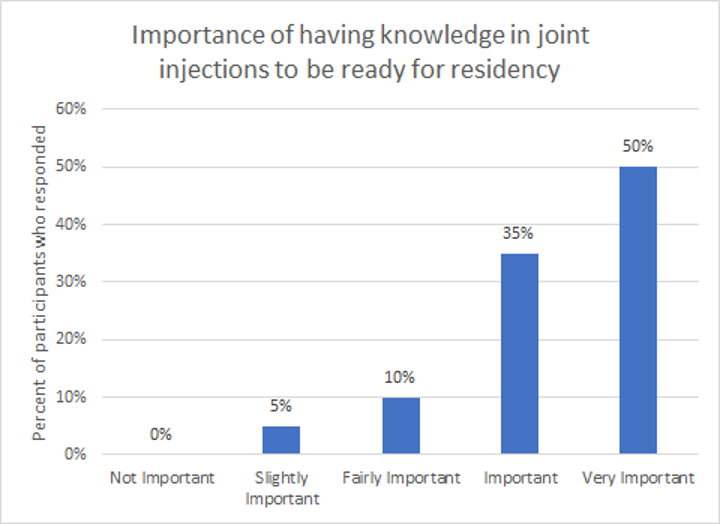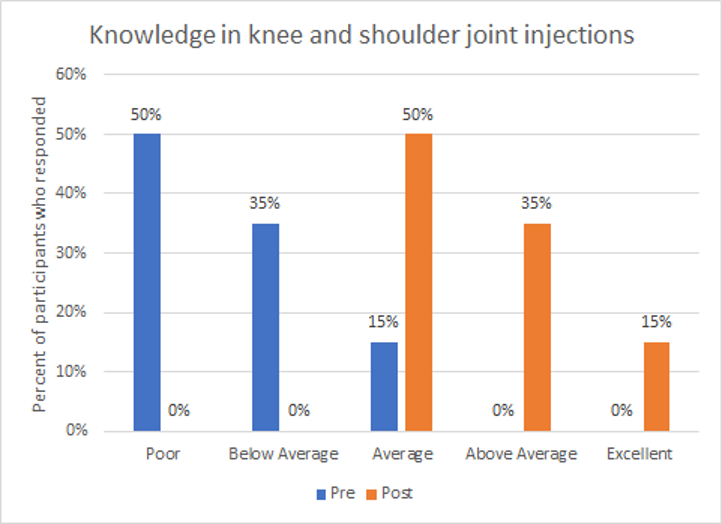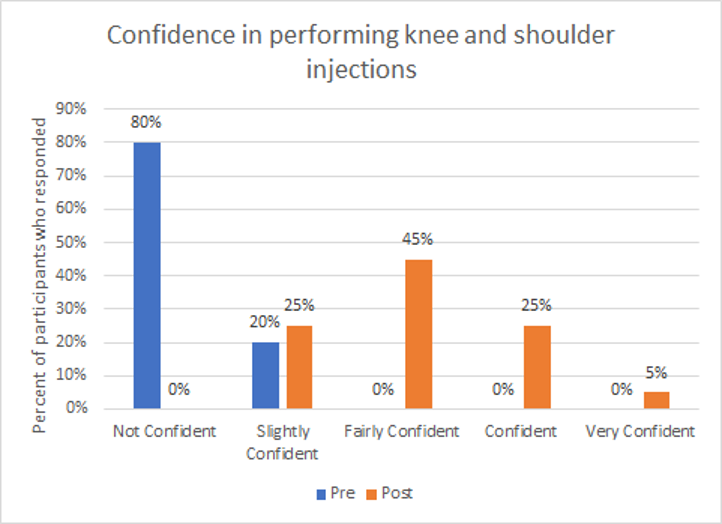Improving Medical Students’ Confidence and Knowledge on Shoulder and Knee Joint Injection Using an Injection Workshop
by Sumira Koirala, MD, St Elizabeth Boardman Family Medicine Residency, Boardman, OH
Background
Musculoskeletal disorders can cause significant impact on patients’ quality of life and functional status. Joint injections can be effective treatments for musculoskeletal issues; however, studies show that up to 95% of primary care providers report that they have been inadequately trained in joint injection techniques during undergraduate and postgraduate training,1 and there is a marked discrepancy between the musculoskeletal knowledge and skill requirements of a primary care physician and the time devoted to musculoskeletal education in undergraduate training.2 Studies show that a workshop for joint injection/arthrocentesis procedures using synthetic joint models, in conjunction with other learning activities such as lectures, result in development of important baseline knowledge and significant improvements in the skill and confidence of learners in performing these procedures.3-5 We have implemented a joint injection workshop for our medical students with a goal of introducing the basic concepts of knee and shoulder joint injection and increasing the knowledge about joint injection and confidence to perform these procedures.
Implementation
The third- and fourth-year medical students who rotate at St. Elizabeth Boardman family medicine residency participate in a 60- minute joint workshop instructed by a family medicine faculty. The students receive both lecture and hands-on instruction. Lecture includes review of anatomy, indications and contraindications of the procedures, and equipment required to perform the procedures. This is followed by demonstration of joint injection by a faculty member. The students then practice their technique on models under supervision. The objectives of the workshop are that after participating in the workshop, students will be able to recall important anatomical landmarks of shoulder and knee joints, report higher confidence in their ability to perform a shoulder injection, report higher confidence in their ability to perform an intra-articular knee injection, and describe the indications, risks, and benefits of a shoulder and knee joint injection.
Methods for Measuring Outcomes
We surveyed twenty medical students who rotated between September 2020 and February 2021 before participating in the workshop about their opinion regarding the importance of having knowledge in joint injection to be ready for residency. They were then asked to rate their knowledge on shoulder and knee injections and their confidence to perform these injections. They were also surveyed postworkshop to assess their perception of improvement in knowledge of and confidence in performing the knee and shoulder joint injections. We used anonymous paper questionnaires using Likert scales for the survey; 20 students participated in this study (100% response rate).
Results
The results of the survey are shown in figures below. A majority of medical students reported that they feel it is important to have knowledge in joint injection to be ready for residency but didn’t have enough knowledge or confidence to perform shoulder and knee joint injections. After participating in the workshops, students felt that their knowledge and confidence to perform joint injections improved.
Figure 1: Importance of Having Knowledge in Joint Injections to Be Ready for Residency

Figure 2: Knowledge in Knee and Shoulder Joint Injections

Figure 3: Confidence in Performing Knee and Shoulder Injections

Discussion
Workshop-style teaching sessions can provide meaningful improvements in medical students’ confidence and knowledge regarding performing shoulder and knee joint injections.6 Using joint models allows them to practice the techniques without any risk of causing harm to patients. The students who have procedure courses during undergraduate training are likely to become more competent in performing procedures in residency and in practice.
References
- Jolly M, Curran JJ. Underuse of intra-articular and periarticular corticosteroid injections by primary care physicians: discomfort with the technique. J Clin Rheumatol. 2003;9(3):187-192. doi:10.1097/01.RHU.0000073587.90836.23
- Pinney SJ, Regan WD. Educating medical students about musculoskeletal problems. Are community needs reflected in the curricula of Canadian medical schools? J Bone Joint Surg Am. 2001;83(9):1317-1320. doi:10.2106/00004623-200109000-00004
- Vogelgesang SA, Karplus TM, Kreiter CD. An instructional program to facilitate teaching joint/soft-tissue injection and aspiration. J Gen Intern Med. 2002;17(6):441-445. doi:10.1046/j.1525-1497.2002.10310.x
- Barilla-Labarca M-L, Tsang JC, Goldsmith M, Furie R. Design, implementation, and outcome of a hands-on arthrocentesis workshop. J Clin Rheumatol. 2009;15(6):275-279. doi:10.1097/RHU.0b013e3181b68a62
- Ladurner A, Nijman T, Gill TK, Smitham PJ. The impact of a hands-on arthrocentesis workshop in undergraduate medical education. BMC Med Educ. 2020;20(1):260. doi:10.1186/s12909-020-02174-6
- Seifert M, Holt C, et al. Improving internal nedicine resident comfort with shoulder and knee joint Injections using an injection workshop. MedEdPortal; 2020. doi:10.15766/mep_2374-8265.1097
